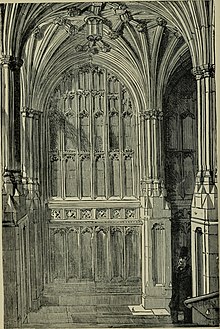Chapel of St Mary Undercroft
| St Mary Undercroft | |
|---|---|
| Chapel of Saint Mary Undercroft | |

Print from the Guide to the Palace of Westminster (1911)
|
|
| Coordinates: 51°29′58″N 0°7′30″W / 51.49944°N 0.12500°W | |
| Location | Palace of Westminster, London |
| Country | United Kingdom |
| Denomination | Church of England |
| History | |
| Founded | 1297 |
| Dedication | Blessed Virgin Mary |
| Administration | |
| Diocese | Royal Peculiar |
| Laity | |
| Director of music | Simon Over |
The Chapel of St Mary Undercroft is a Church of England chapel in the Palace of Westminster.
It had been a crypt below St Stephen's Chapel and had fallen into disuse, being pressed into service at various times as a wine cellar, dining room for Speakers (who had holes bored into the wall to accommodate two kitchen chimneys) and (now unconfirmed by records) stables for Oliver Cromwell's horses.
After a fire had destroyed St Stephen's Chapel in 1834, the undercroft returned to its former use as a place of worship. Although much stonework was damaged in the fire, it was decorated in the 1860s by Edward Middleton Barry with gilded, painted and stenciled designs in rich colours to cover the walls, floor and vaulting. The backdrop of the altar depicts royal British saints.
On census night, 2 April 1911, suffragette Emily Davison hid overnight in a cupboard in the Chapel in order to be entered on the census form for the building as a way of ensuring her address on the night of the census was recorded as the House of Commons in claiming political equality with men. A commemorative plaque, unveiled by Tony Benn in 1999, is fixed to the cupboard.
It is still used for worship purposes today. In particular, children of peers, who possess the title of "The Honourable", have the privilege of being able to use it as a wedding venue. In addition, members of parliament and peers have the right to use the chapel as a place of christening in the baptistery and font (whose basin was made from a single slab of alabaster) designed by Barry.
It is a Royal Peculiar chapel - outside the responsibility of any diocesan bishop. The building is administered through the Lord Great Chamberlain and Black Rod and it has no dedicated clergy: by convention services were conducted by the Rector of St Margaret's, Westminster, a member of the Chapter of Westminster Abbey. In 2010 the Speaker of the House of Commons used his right of appointment to nominate an outsider, Revd. Rose Hudson-Wilkin as the Speaker's Chaplain.
...
Wikipedia
